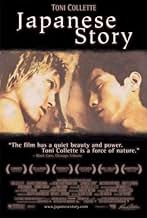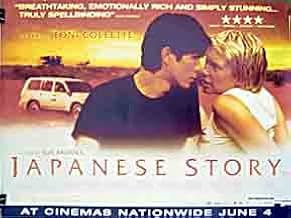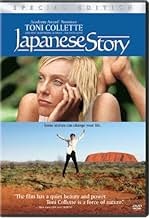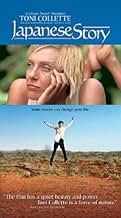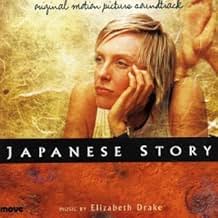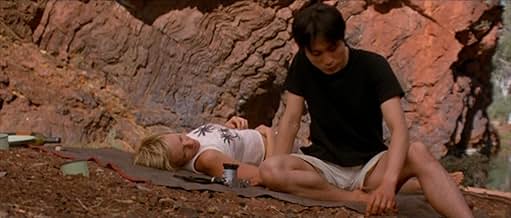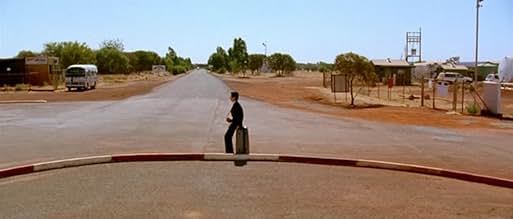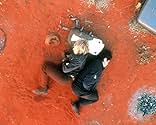CALIFICACIÓN DE IMDb
6.8/10
6.9 k
TU CALIFICACIÓN
Sandy, una geóloga, se encuentra atrapada en un viaje de campo al desierto con Hiromitsu, un hombre japonés que considera arrogante Las cosas van de mal en peor cuando se quedan varados en u... Leer todoSandy, una geóloga, se encuentra atrapada en un viaje de campo al desierto con Hiromitsu, un hombre japonés que considera arrogante Las cosas van de mal en peor cuando se quedan varados en una de las regiones más remotas de la tierra.Sandy, una geóloga, se encuentra atrapada en un viaje de campo al desierto con Hiromitsu, un hombre japonés que considera arrogante Las cosas van de mal en peor cuando se quedan varados en una de las regiones más remotas de la tierra.
- Premios
- 20 premios ganados y 13 nominaciones en total
Jules Hutchinson
- Canteen Worker
- (as Jules Hutchison)
- Dirección
- Guionista
- Todo el elenco y el equipo
- Producción, taquilla y más en IMDbPro
Opiniones destacadas
10Adetunji
This is, apparently, a love it or hate it movie. As is the case with such films those on one side have a hard time understanding the view of the opposite. I am fully in that camp, I thought this film was stark and beautiful--as moving in its silence and mundane moments as it was illuminating. For those who say there is no plot, well I clearly saw a different film, there is more story and intention in simple small details as there are in a whole series of other films. Toni Collette was amazing and Gotaro Tsunashima was perfect, capturing the emotional compression and exploration of his character with clarity and skill. In a film full of striking absolutely believable and full moments -- the furtive exploratory glances as the two leads drive through the desert, and Toni's fascination with Gotaro's nearly hairless arms say so much about the characters', their history, their assumptions, their prejudices. Incredibly moving, shattering emotionally, and ultimately deeply profound. A haiku-like meditation on living and sharing--I loved it.
In an age when criticism has become debased and few people are really certain about what constitutes true worth in art, it is difficult to use the word "masterpiece" about any film. And yet that word is applicable here. At first this film appears to be just a bog-standard romantic love story, in the Hollywood mould, about two very different characters who meet and fall in love in unusual circumstances. Opposites attract, and so on.
However, as the story unfolds one becomes aware that there are many more levels to it than one would normally expect. Everything, from the title to incidental characters and the spectacular images of the desert, has been carefully thought out. It raises profound questions about a fashionable subject: identity, but also about love itself. Are these characters in love, or is it merely the terrifying starkness of the Australian outback that has thrown them together? Finally a third person enters the relationship, who complicates matters even further. Despite the romantic overtones of this film it is lifted, ultimately, by its absolute realism. Small gestures betoken whole story lines and glimpses of other characters throw the protagonists into sharp relief. Other influences begin to trickle through: Yasujiro Ozu, Peter Weir (in his early days), Japanese Haiku. And yet this is an entirely original work.
This film had a huge emotional impact on me, but it also made me think, about my own life and about the choices I've made. It did everything that a genuine work of art should do, and without any of the fanfare that we, in the West, have come to associate with art. Small wonder that it got little of the attention that in previous eras it would have attracted. Watch it, and discover that it is still possible to make a classic.
However, as the story unfolds one becomes aware that there are many more levels to it than one would normally expect. Everything, from the title to incidental characters and the spectacular images of the desert, has been carefully thought out. It raises profound questions about a fashionable subject: identity, but also about love itself. Are these characters in love, or is it merely the terrifying starkness of the Australian outback that has thrown them together? Finally a third person enters the relationship, who complicates matters even further. Despite the romantic overtones of this film it is lifted, ultimately, by its absolute realism. Small gestures betoken whole story lines and glimpses of other characters throw the protagonists into sharp relief. Other influences begin to trickle through: Yasujiro Ozu, Peter Weir (in his early days), Japanese Haiku. And yet this is an entirely original work.
This film had a huge emotional impact on me, but it also made me think, about my own life and about the choices I've made. It did everything that a genuine work of art should do, and without any of the fanfare that we, in the West, have come to associate with art. Small wonder that it got little of the attention that in previous eras it would have attracted. Watch it, and discover that it is still possible to make a classic.
"Japanese Story" is a fascinating exploration of gender and cultural roles, with a more incisive take on the contrasts than "Lost in Translation," let alone than in the simplicity of "The Last Samurai."
The Australian outback is a harsher but beautiful landscape of blokes and sheilas than the Manhattan of "Sex and the City" but it brings into relief similar questions of expectations of guys and gals in life and sex.
Toni Colette's "Sandy" is one tough geologist required to guide Gotaro Tsunashima to his father's company's environment-destroying mining businesses. Each suspiciously views the other through narrow stereotypical lenses that block out the complexities of their real lives and potential.
They very gradually adapt to each other, opening each other up to new experiences in quite unexpected ways, even though their language and life communication is still limited. She is the shaggy, physical, confident one; he is the smooth, intellectual, diffident one. "Sandy" is aggressive in a way much more typical of males in U.S. movies, while "Tachibana" is redolent of the farm wife in "The Bridges of Madison County."
The third act is even more startling in its catharsis for "Sandy" as she finds inner strengths and vulnerabilities to deal with her responsibilities across the cultural chasm.
The Australian outback is a harsher but beautiful landscape of blokes and sheilas than the Manhattan of "Sex and the City" but it brings into relief similar questions of expectations of guys and gals in life and sex.
Toni Colette's "Sandy" is one tough geologist required to guide Gotaro Tsunashima to his father's company's environment-destroying mining businesses. Each suspiciously views the other through narrow stereotypical lenses that block out the complexities of their real lives and potential.
They very gradually adapt to each other, opening each other up to new experiences in quite unexpected ways, even though their language and life communication is still limited. She is the shaggy, physical, confident one; he is the smooth, intellectual, diffident one. "Sandy" is aggressive in a way much more typical of males in U.S. movies, while "Tachibana" is redolent of the farm wife in "The Bridges of Madison County."
The third act is even more startling in its catharsis for "Sandy" as she finds inner strengths and vulnerabilities to deal with her responsibilities across the cultural chasm.
8=G=
It would be impossible to say anything substantially meaningful about "Japanese Story" without spoiling the film for those who have not seen it. Suffice it to say, it's set in Australia and works with a an Aussie woman (Colette) and a Japanese man (Hiromitsu) to build slowly to an emotionally potent situation - a series of moments - and then lingers in the denouement allowing the audience to savor the emotions evoked. For some, those feelings may be nil. For others they may be powerful and overwhelming. Personally, I wept. Objectively, the film, about a woman by women, is well crafted and Colette's performance is outstanding. The film deserves high marks in all aspects from cinematography to music to casting, etc. However, when the closing credits roll, your experience will have been as unique as yourself. And whatever that experience is, it will be less if you know the outcome in advance. (B+)
I think it's one of those memorable movies you'll think about for a long time, but it also seemed to go on for a long time while you're watching it. I think Americans aren't all that comfortable with the very leisurely pace of a lot of foreign films, and that may have been part of the problem -- but there's only so long you can watch someone expressing an emotion before you want to say "I get it, I get it -- can we move on to what happens next?" The plot involves a headstrong young Japanese businessman's visit to the most desolate part of Australia -- a rather tough geologist played by Toni Collette (Muriel's Wedding) is his tour guide. He doesn't quite understand how different Australia is from Japan, and Collette has her hands full trying to chauffeur him around. The movie centers around the relationship that develops between these two very different people, set in the mind-bogglingly desolate Australian outback.
If your idea of a great movie involves car chases, this is definitely not the movie for you. If you like slower and more nuanced movies, then this one is definitely worth seeing.
If your idea of a great movie involves car chases, this is definitely not the movie for you. If you like slower and more nuanced movies, then this one is definitely worth seeing.
¿Sabías que…?
- ErroresWhen the QANTAS jet to Kyoto leaves, it is actually leaving from the Perth domestic airport. The international terminal, where it would really leave from, and the Darling Ranges to the east, are clearly visible in the background.
- Créditos curiososOur thanks to the people of Nyamal, Ngarluma, Yinjibarndi, Bunjima and Nyiparli Nations.
- ConexionesFeatured in Inside Japanese Story: an evening with the film-makers (2004)
- Bandas sonorasABC News Theme
(1986)
Written by Tony Ansell (as T. Ansell) and Peter Wall (as P. Wall)
Published by ABC Music Publishing and
Kindly reproduced with the permission of the Australian Broadcasting Corporation
Selecciones populares
Inicia sesión para calificar y agrega a la lista de videos para obtener recomendaciones personalizadas
- How long is Japanese Story?Con tecnología de Alexa
Detalles
- Fecha de lanzamiento
- País de origen
- Sitios oficiales
- Idiomas
- También se conoce como
- Japanese Story
- Locaciones de filmación
- Productoras
- Ver más créditos de la compañía en IMDbPro
Taquilla
- Presupuesto
- USD 5,740,000 (estimado)
- Total en EE. UU. y Canadá
- USD 647,054
- Fin de semana de estreno en EE. UU. y Canadá
- USD 23,962
- 4 ene 2004
- Total a nivel mundial
- USD 4,098,613
- Tiempo de ejecución1 hora 46 minutos
- Color
- Mezcla de sonido
- Relación de aspecto
- 2.35 : 1
Contribuir a esta página
Sugiere una edición o agrega el contenido que falta

Principales brechas de datos
What is the English language plot outline for Una Historia Infiel (2003)?
Responda






